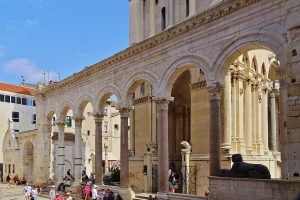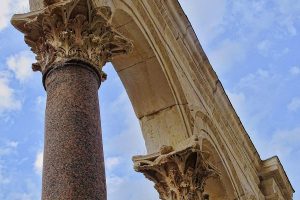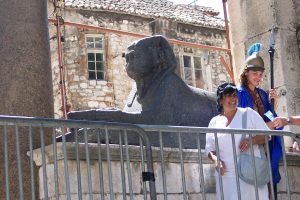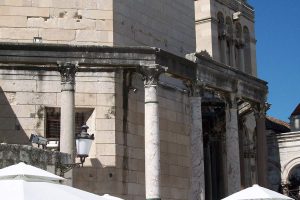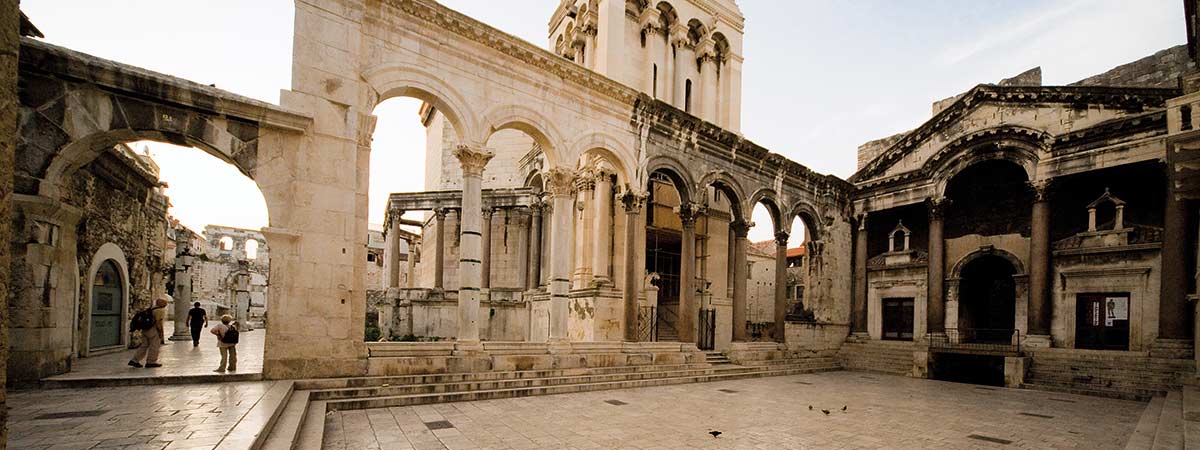
Peristyle – The Center of Split and of the World
Diocletian’s Palace is one of the largest and best-preserved examples of Roman architecture in the world. What’s more, it’s the beating heart of the city of Split. One of the palace’s most important and most loved parts is the Peristyle. This was originally the courtyard of the fortress built by one of the last Roman emperors. Now it is a modern square where people meet with friends, relax, have fun and explore the ancient past of the beautiful coastal city. It’s time for your exploration to begin.
What Is the Peristyle?
A peristyle or peristylium is an architectural term dating back to Ancient Greece. Both the wealthy Greeks and Romans had a peristyle or an inner courtyard within their villa. One of its major characteristics is the set of columns that surround it. The Peristyle of Diocletian’s Palace was naturally more monumental compared to what the rest of the noblemen of Rome had. Still, it had the characteristic columns which are preserved to this day. The courtyard is also paved. Most likely, it didn’t serve solely as a place for relaxation of the emperor, but rather as a venue for religious and other public events.
The Courtyard’s Significance
It is easy to see that the Peristyle is strategically positioned within Diocletian’s palace. It would provide the emperor and his courtiers with direct access to his quarters. Diocletian’s mausoleum is on the East of the courtyard signifying the importance of this open area as a gathering place for the crowds that would pay tribute to the emperor. The mausoleum remained a place of worship over the ages – it was transformed into what is now the Cathedral of Saint Domnius which you should definitely visit during your holiday in Split.
Peristyle on Instagram
[ess_grid alias=”Peristyle”]
On the west side of the courtyard Diocletian built three temples. The only one which has survived to this day is the Temple of Jupiter, the god of the sky and the king of the gods in Roman mythology. Just like Diocletian’s mausoleum it later became a place of worship for Christians. More specifically, it was turned into a baptistery.
It is safe to say that the Peristyle was part of a complex devoted to religion and to the worship of Diocletian. Quite close to the courtyard there is another Roman temple which is standing that of Aesculapius, the god of medicine. One interesting fact about it is that its cylindrical roof constructed entirely of stone blocks carved by hand remained completely intact until around the middle of the 20th century. The Temple of Aesculapius has undergone restoration and its beauty can now be admired by everyone.
From Ancient Worship to Modern Culture
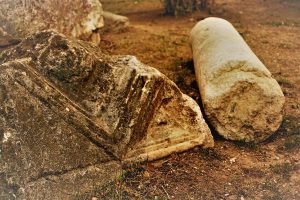 When you step on the polished stones of the Peristyle, it’s easy to imagine how Diocletian entered with his imperial garments and walked among the cheering crowd. It is believed that the column’s material, red granite, was purposefully chosen to highlight the connection between him and the gods. Hundreds of years have passed since then, but the grandeur of the place has been excellently preserved. You can still marvel at the elaborate decoration of the columns while sitting on a bench in the courtyard. The place is so inspiring that even Pope John Paul II exclaimed with awe when he walked into it.
When you step on the polished stones of the Peristyle, it’s easy to imagine how Diocletian entered with his imperial garments and walked among the cheering crowd. It is believed that the column’s material, red granite, was purposefully chosen to highlight the connection between him and the gods. Hundreds of years have passed since then, but the grandeur of the place has been excellently preserved. You can still marvel at the elaborate decoration of the columns while sitting on a bench in the courtyard. The place is so inspiring that even Pope John Paul II exclaimed with awe when he walked into it.
After the collapse of the Roman empire, the noblemen and soldiers were gone, but the common people started building their homes and establishing their stalls and shops within the walls of the fortress. This is how the Peristyle became the heart of Split. Around it, you will discover not only ancient temples, but also fine examples of Renaissance and Gothic architecture which reveal the way of life of the most influential families in the city.
When you visit Split and Diocletian’s Palace, don’t just go quickly around the open courtyard. Sit on a bench and explore its magnificent architecture. Don’t miss to check the cultural calendar of the city to find out if the ancient courtyard will host an event such as a musical concert, an opera performance or a play while you will be staying here. The surrounding buildings, which appear as symbols of different times and cultures, serve as the perfect backdrop and the acoustics are simply amazing. It’s easy to feel as if you are in the center of the world when standing in the Peristyle.


